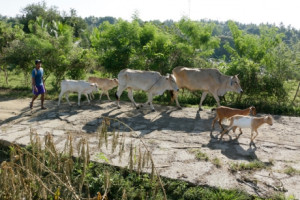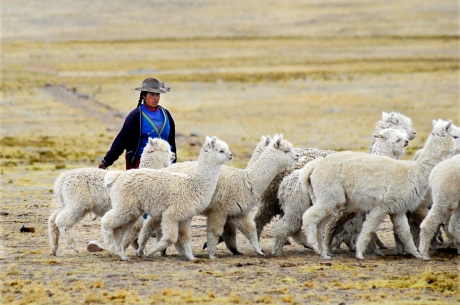
Photo ©FAO/Joseph Agcaoili
This time-tested practice works with nature and offers numerous benefits

Pastoralism, a traditional and extensive form of raising livestock, employs more than 200 million people in 100 countries. Pastoralists guide and feed their animals through diverse landscapes such as prairies, savannas or tundra.
Employing different species of local breeds that adapt to variable environments, pastoralism is critical to reducing poverty and providing food security in these areas. By working with nature, it champions productivity, sustainability and animal welfare.

Here are seven reasons why pastoralism plays a key role for a better future:
1. It diversifies food production
In a world where the availability of natural resources and climate patterns are increasingly variable, meeting demand for milk and meat through different methods, including pastoralism, spreads the risk of production failures. Pastoralism provides affordable, high-quality proteins and nutrients to meet local demand and can help reduce a country’s reliance on imports. And because herders travel with their livestock and work knowledgeably with nature to access water and forage, production inputs are low relative to outputs.
2. It acts against climate change
Research shows that pastoral landscapes have the potential to achieve a neutral carbon balance, as grazing can offset carbon levels by stimulating plant growth, which helps sequester carbon in soil. In pastoral systems, livestock can also be moved to fallow lands and fields to make use of crop residues for feed and to distribute animal manure as fertilizer – recycling nutrients as part of a circular bioeconomy.
By moving livestock around, pastoralism diversifies strategies for adapting to a changing climate. For example, in Mongolia, pastoralists make use of “otor” – reserved areas that can be used in times of crisis, such as the late arrival of rains – thereby preserving other rangeland areas from overgrazing. Pastoralists also effectively manage natural resources, helping preserve biodiversity in all kinds of environments, from deserts to wetlands and forests. Thus, respecting and incorporating pastoralists’ knowledge and practices can help protect these ecosystems.
3. It functions as an early warning system for pandemics
The COVID-19 pandemic has taught us that dealing with health challenges requires paying attention to the health of animals, the environment, and humans. The One Health approach helps countries better monitor and control zoonotic diseases (those that pass between humans and animals). Pastoralists play an essential role in this, providing early warnings of new infectious disease threats in wildlife populations. Improving access to veterinary services and prevention measures – including affordable quality vaccines – will help meet production needs while reducing the risk of disease transmission.
Between 2016 and 2019, FAO vaccinated approximately 30 million small ruminants against Peste des Petits Ruminants in the pastoral areas of Ethiopia. FAO also supports farmers and pastoralists on the responsible use of antimicrobials in livestock to help control the emergence and spread of drug-resistant pathogens through the food supply chain and into the environment.
4. It strengthens the labour force and offers employment opportunities
Pastoralism secures the livelihood of millions of people in 75 percent of the world’s countries, but has been neglected for years by policies and investments. Boosting pastoralists’ access to education, training, information, markets, veterinary and animal production support, health and finances and facilitating transboundary movement can yield substantial economic and social benefits.
5. It reduces feed-food competition
Consumer demand for naturally raised and grass-fed animal sourced foods continues to expand the retail market of these products, presenting new opportunities for exports and profitability. It is estimated that up to 811 million people in the world faced hunger in 2020. Grazing systems can help reduce food insecurity by reducing the competition for cereals between livestock feed and food for human consumption.

6. It protects animal diversity
Pastoral herds and flocks have been bred for thousands of years, resulting in some of the highest levels of genetic diversity and resilience of any breeding population. This diversity of local breeds stems from a close inter-dependency between the environment, pastoralists and livestock. Through genetic selection and local ecological knowledge, herders continuously improve their animals’ breed, allowing them to adapt to environmental changes, diseases and changing market preferences. The need to interact and work with other herds also allows for greater genetic diversity.
7. It helps forests grow
Pastoralism and forests are interdependent. In some areas, riparian forests (those close to a body of water) are a significant grazing resource for livestock during dry seasons. In exchange, pastoralism helps maintain and renew these lands. For example, ruminants facilitate the germination of acacia tree seeds in dryland forests by digesting them, allowing water and air through the weakened outer seed coating. Pastoralists in Europe remove blackberries that prevent the regrowth of larger trees. Herders also play a role in preventing wildfires, as their animals remove biomass in forests.
Despite providing many benefits – from helping combat climate change to preserving heritage and biodiversity–pastoralism faces threats from rural exodus and, in some regions, discrimination, conflicts and insecurity. FAO is helping support pastoralists worldwide and is cooperating with local governments, research centres, and pastoral organizations to improve knowledge, methodologies, and tools to tackle these challenges and support the preservation and development of pastoralism worldwide.
Source: the FAO News and Media office
-global bihari bureau





